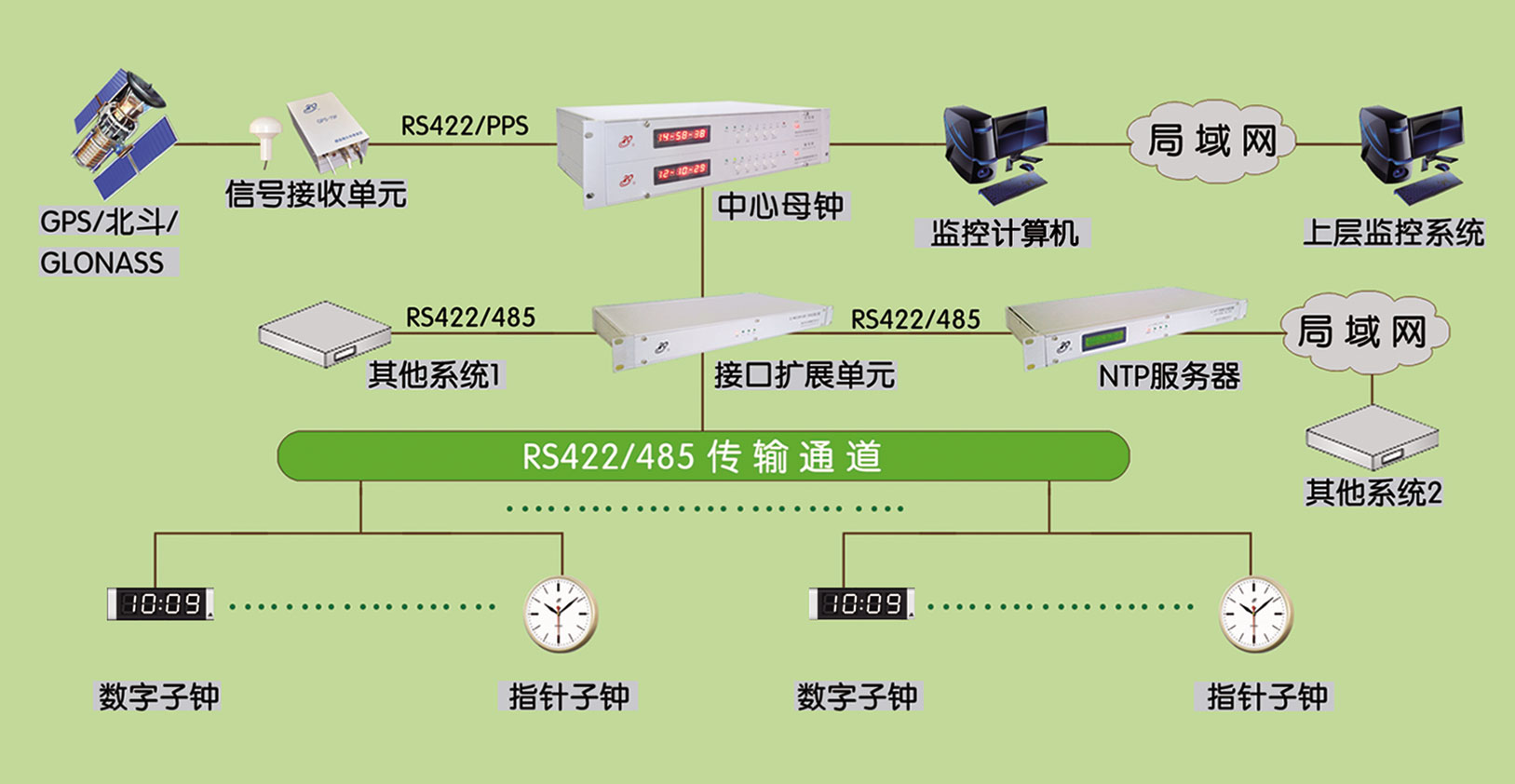School / Hospital / Smart Building Time System Solutions

Basic Features
The central master clock receives the standard time signal from GPS/Beidou/GLONASS, transmits it to the slave clock through the interface expansion unit, and provides it to other users by the NTP server and the interface expansion unit to realize the time synchronization of the whole system. At the same time, the state monitoring of the whole system is realized through the monitoring computer, and the state information can be provided to the upper-level monitoring system.
Key Features
The system applies the world's advanced information technology, absorbs the concept of industrial control, follows the principle of equal emphasis on advancement and practicability, considers scalability and compatibility, innovation center monitoring, redundant backup, power failure protection, fault diagnosis, automatic alarm, etc. The key technology realizes high precision and high reliability of system time synchronization. At the same time, the appearance design of the equipment and the decoration style of the site are coordinated with each other to achieve the perfect combination of function and appearance.
Technical parameters
The system adopts two-layer structure of central master clock and slave clock, and RS422/485 communication. The system solves the accuracy and stability of the regional clock synchronization system through the unique core technology groups such as PPS back compensation, high-precision RS422/485 time synchronization, output intelligent judgment, parallel undisturbed redundancy, time closed-loop feedback and system-wide fault detection. Sexual problems, so that the clock synchronization technology leads the international level. The system is mainly used in regional clock synchronization, such as railway stations, bus stations, power plants, standard workshops, TV stations, schools, hospitals, intelligent buildings, gymnasiums and other occasions.
System Parameters
| 1) System Architecture: | Two layers |
2) Communication protocol: | Dedicated RS422/RS485 and NTP protocols |
3) Communication distance: | ≤1200m (over 1200m add repeater) |
4) Number of secondary master clocks: | Can bring pointer sub-clocks and digital sub-clocks 320 faces |
5)System synchronization error: | Sub clock≤10ms, NTP server≤2ms |
Device parameters
| GPS/Beidou/GLONASS Signal Receiving Unit | |
| 1) Operating temperature: | -30℃~+65℃ |
2) Relative Humidity: | ≤95% |
3) Frequency stability: | 10-12~10-9 |
4) Sync Error: | GPS≤50ns, Beidou≤100ns, GLONASS≤30ns |
5) Signal transmission distance: | ≤1200m |
6) Interface: | Standard RS422/485 |
7) Antenna feeder length: | 5~100m (standard 30m) |
8) Power supply: | AC220V±15% 50Hz±5% |
| 9) Power consumption: | ≤20W |
| 10) MTBF: | ≥85,000 hours |
| 11) Antenna: | With dustproof, waterproof, anti-corrosion, lightning protection |
Secondary Master Clock | |
1) Self-timer precision: | ±0.01s/d |
2) Working temperature: | -10℃~+65℃ |
3) Relative Humidity: | ≤95% |
4) Interface: | Standard RS422/RS485/RS232/NTP |
5) Number of standard output ports: | 2 |
6) The number of sub-clocks that can be built: | ≤320 sides |
7)Power: | AC220V±15% 50Hz±5% |
8) Power consumption: | ≤20W |
| 9) MTBF: | ≥85,000 hours |
| NTP server | |
| 1) Operating temperature: | -10℃~+65℃ |
| 2) Relative Humidity: | ≤95% |
| 3) Sync Error: | ≤2ms |
| 4) Output interface: | 10BaseT/100BaseT Ethernet interface |
| 5) Number of output ports: | 1 to 4 |
| 6) Client capacity: | 8000 times/sec |
| 7) Protocol: | SNTP/NTP V2,V3,V4, etc. |
| 8) Management port: | remote management via ethernet interface |
| 9) Power supply: | AC220V±15% 50Hz±5% |
| 10) Power consumption: | ≤10W |
Analog Clock | |
1) Self-precision: | ±0.05s/d |
2) Output torque: | 800~1200g. cm |
3) Working temperature: | -35℃~+70℃ |
4) Relative Humidity: | ≤95% |
5) Working voltage: | AC220V±15% 50Hz±5% |
| 6) MTBF: | ≥85,000 hours |
Digital Clock | |
| 1) Self-precision: | ±0.05s/d |
| 2) Working temperature: | -35℃~+70℃ |
| 3) Relative Humidity: | ≤95% |
| 4) Working voltage: | AC220V±15% 50Hz±5% |
| 5) LED luminous intensity: | ≥1000mcd |
| 6) MTBF: | ≥85,000 hours |
